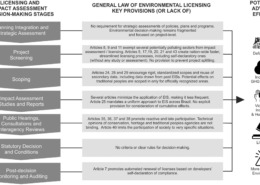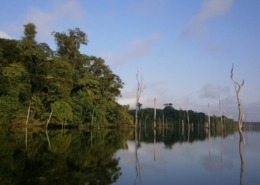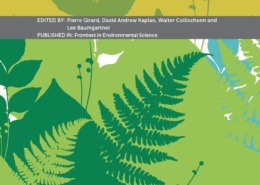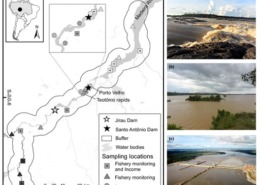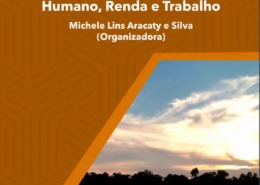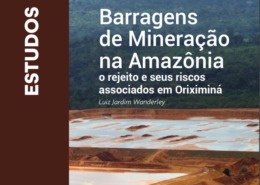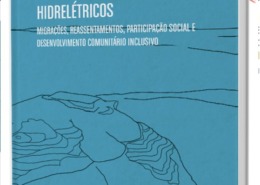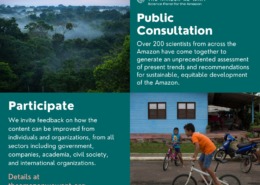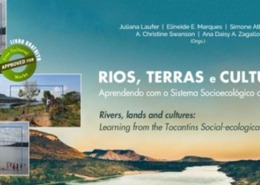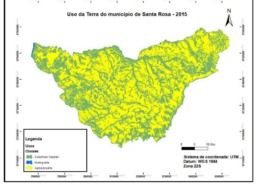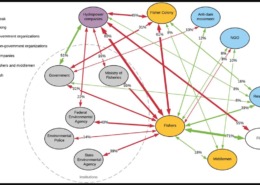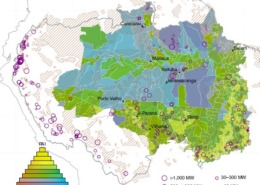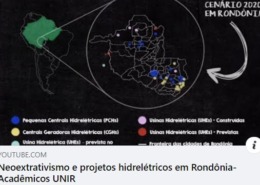New paper: “Stakeholder Perceptions on the Governance of Fisheries Systems Transformed by Hydroelectric Dam Development in the Madeira River, Brazil”
New paper by ADN members and colleagues Carolina R. C. Doria, Jynessa Dutka-Gianelli, Mariluce Paes de Souza, Kai Lorenzen and Simone Athayde
ABSTRACT
Hydroelectric dams often have significant impacts on freshwater fisheries. Major impacts are known to be driven by changes in river hydrology and fish ecology, but the role of governance arrangements in mitigating or exacerbating fisheries impacts from hydropower development is less understood. This study presents an analysis of stakeholder perceptions about the effects of hydroelectric dam implementation on fisheries governance arrangements in the Madeira River basin, Brazil. Semi-structured interviews were conducted with 50 stakeholders representing the fishers and fish traders, government, non-governmental organizations, and the private sector. Fishers, non-governmental, and private sector agents perceived hydropower development to be the strongest factor driving fisheries decline or change over the past 10 years, while government staff perceived overfishing to be an equally or even more important factor. Most stakeholders affirmed that fisheries governance arrangements have weakened in the face of hydropower development, and that these arrangements have been insufficient to effectively mitigate or compensate for negative impacts on fisheries. Fishers, non-governmental and private sector agents saw lack of opportunities to participate in fisheries governance as a major contributing factor, while government staff emphasized lack of qualified personnel, lack of trust between agencies, and control over the decision-making process held by hydropower companies. Perspectives on other implications of governance arrangements were shared across stakeholder groups. These included increased conflicts; lack of interaction and coordination between agencies; the fragility of fishers’ social organization; lack of trust and reciprocity between organizations; and power imbalances between stakeholders. The results show that hydropower development impairs and changes relationships between diverse players involved in fisheries governance, which can exacerbate existing weaknesses and negatively affect fishery sustainability. Drawing from the perspectives and comments of the various stakeholders who participated in the study, we provide recommendations to improve freshwater fisheries governance in the Madeira River basin and in the Brazilian Amazon.
Este estudo apresenta uma análise das percepções dos atores sobre os efeitos da implementação de barragens hidrelétricas nos arranjos de governança da pesca na bacia do rio Madeira, Brasil. Com base nas perspectivas e comentários de vários atores que participaram do estudo, são fornecidas recomendações para melhorar a governança da pesca de água doce na bacia do rio Madeira e na Amazônia brasileira.

FIGURE 4. Cognitive map of the Madeira Fisheries System after implementation of the Santo Antônio and Jirau dams. The circles represent the institutions cited by the respondents: the green lines represent strong relationships that contribute to sustainability, while red lines represent weak relationships that do not contribute to the fishing sustainability. Line density represents the percentage of responses related to all answers.
Forgetting people in energy development of Belo Monte and other dams
Rios, Terras e Culturas: aprendendo com o Sistema Socioecológico do Tocantins (Rivers, lands and cultures: Learning from the Tocantins Social-ecological System)
Juliana Laufer; Elineide E. Marques; Simone Athayde; A. Christine Swanson; Ana Daisy A. Zagallo (Orgs.)
Chapter 3.2 is entitled “Forgetting people in energy development of Belo Monte and other dams”. This chapter shows that people are often overlooked in the process of planning hydroelectric dams as observed in the case of Belo Monte and other dams. Many populations dependent on the river were forced to leave their homes and were resettled in urban communities, dramatically changing their lives. The impacts caused on the lives of these people are not sufficiently considered in planning and mitigation. The authors emphasize that it is necessary to think about a sustainable way to produce energy and compensate the people who are impacted by the dams because in addition to not receiving the energy that is being generated by the dam, they still pay a high price for the energy consumed. To address this, a technology proposal is presented that will not affect fishery production or require resettlement. The proposed approach is to install small turbines close to a local community to generate energy for that community rather than for far-off places. This approach does not interrupt the flow of water or require resettlements.
O capítulo 3.2 tem como título “Esquecendo as pessoas no desenvolvimento energético de belo monte e outras barragens”. O texto mostra que as pessoas são frequentemente esquecidas no processo de planejamento de hidrelétricas, como observado no caso de Belo Monte e outras barragens. Muitas populações dependentes do rio foram forçadas a sair de suas casas, foram reassentadas em comunidades urbanas, mudando drasticamente suas vidas. Essas mudanças e os impactos causados na vida dessas pessoas não são suficientemente considerados. O texto ressalta que é necessário pensar em uma maneira sustentável de produzir energia e compensar as pessoas que são impactadas, pois, além de não receberem a energia que está sendo gerada ainda pagam alto preço pela energia consumida. Nesse sentido, é apresentada uma proposta de tecnologia que não afetará a produção pesqueira nem exigirá reassentamento. O projeto é instalar pequenas turbinas próximas a uma comunidade local para gerar energia para essa comunidade e não para lugares distantes, sem interromper o fluxo de água nem exigir reassentamentos.
Link: https://www.editorafi.org/19rios
For each chapter the version in Portuguese is followed immediately by the version in English.
Hydroelectric dams and Amazonian traditional peoples: elements for a preliminary and introductory prognosis
Rios, Terras e Culturas: aprendendo com o Sistema Socioecológico do Tocantins (Rivers, lands and cultures: Learning from the Tocantins Social-ecological System)
Juliana Laufer; Elineide E. Marques; Simone Athayde; A. Christine Swanson; Ana Daisy A. Zagallo (Orgs.)
The third section of this ebook, “Speaking to the experts (the experience of researchers)”, consists of four chapters, adapted from experts’ talks at the workshop.
Chapter 3.1 talks about “Hydroelectric dams and Amazonian traditional peoples: elements for a preliminary and introductory prognosis”. The text shows, through the information extracted from the National Energy Plan – PNE 2030, produced by EPE, that the Amazon is the new frontier for hydroelectric power generation. The northern region of Brazil has 343 (more than 50%) of 676 total indigenous territories in the countries, and yet is at the center of the national efforts to expand hydroelectric plants. In view of this, concerns are raised with Indigenous and Quilombola communities, as well as riverside dwellers, fisherpeople and a whole range of communities that may be impacted by these ventures. This full range of affected people and communities are not considered in the criteria that define environmental restrictions. By 2015, the Palmares Cultural Foundation has identified 2,607 Quilombola communities in Brazil. However, according to data from the same year, only 73 communities had their land recognized. This demonstrates another serious problem with the implementation of hydroelectric dams: there is no security for these communities after the dams are built, and the government refuses to recognize Quilombola and Indigenous areas because of the energy expansion policies.
A terceira seção do e-book- “Conversando com os especialistas (A experiência dos pesquisadores)”, é composta por quatro textos, editados a partir das conferências dos especialistas do workshop.
O capítulo 3.1, fala sobre “Hidrelétricas e povos tradicionais na Amazônia: elementos para um prognóstico preliminar e introdutório”. O texto mostra, através das informações extraídas do Plano Nacional de Energia – PNE 2030, produzido pela EPE, que a Amazônia é a nova fronteira de geração de energia hidrelétrica. O Brasil possui 676 terras indígenas e a região norte comporta 343 dessas áreas, ou seja, mais de 50%, e é exatamente a região que está no centro desse projeto de expansão das hidrelétricas. Diante disso, são apresentadas preocupações com comunidades indígenas e quilombolas, e também os ribeirinhos, pescadores e toda uma série de comunidades que poderão ser impactadas por esses empreendimentos, e que não são considerados nos critérios que definem restrições ambientais. Até 2015, a Fundação Cultural Palmares tinha levantado 2.607 comunidades quilombolas no Brasil. Todavia, segundo dados do mesmo ano, somente 73 comunidades tiveram suas terras reconhecidas. Isso nos mostra um outro lado desse grave problema do avanço das hidrelétricas: nós não temos uma segurança para o que ocorrerá com essas comunidades após os empreendimentos e o governo se recusa a reconhecer áreas quilombolas e indígenas em decorrência dessa política de expansão energética.
Link: https://www.editorafi.org/19rios
For each chapter the version in Portuguese is followed immediately by the version in English.

